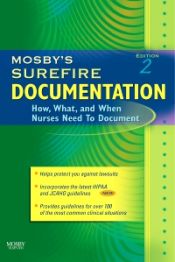Mosby's Surefire Documentation, 2nd Edition offers clear, practical guidelines for how, what, and when to document for more than 100 of the most common and most important situations nurses face. Divided into 3 sections — Caring for Patients, Dealing with Challenging Patient Situations, and Handling Difficult Professional Problems — this essential resource details exactly what information to consider and document, to ensure quality patient care, continuity of care, and legal protection for the nurse and the institution where the nurse works.
New to this edition
- Completely updated content throughout that reflects the latest information and guidelines affecting documentation, including HIPAA and JCAHO standards.
- Expanded coverage of electronic documentation and its implications for nurses.
- A wealth of new and expanded special features such as Charting Checklists, Legal Briefs, and Case Law Close-Ups that further illustrate important documentation and legal considerations
Key Features
- UNIQUE! Case histories that illustrate key legal points
- Tips to help nurses streamline documentation without sacrificing accuracy
- Guidance for documenting unusual or difficult developments or events
- Clear, concise explanations of complex legal terms and concepts
- Advice on how and why to document for a variety of documentation systems
- Charting Checklists identify essential points to record for a particular situation
- Legal Briefs explain legal terms, such as a living will, or give practical advice for avoiding legal pitfalls
- Case Law Close-Ups describe specific court cases, explain the court's ruling, and point out the nursing implications
- Tips and Advice help the nurse solve documentation problems, such as correcting a mistaken entry, and give advice on recording data in complex situations
Did you know? sections present interesting, practical, or little-known points related to a specific topic
Author Information
By Mosby
Part 1: Caring for Patients
When you perform your initial patient assessment
When your patient loses a peripheral pulse
When your patient has chest pain
When your patient has a myocardial infarction
When your patient has heart failure
When your patient is in shock
When your patient has cardiopulmonary arrest
When your patient has a new arrhythmia-NEW!
When your patient has hypertensive crisis- NEW!
When your patient has pneumonia
When your patient has pneumothorax- NEW!
When your patient has an asthma attack
When your patient has a pulmonary embolism
When your patient has pulmonary edema
When your patient has pulmonary tuberculosis
When your patient has severe pain
When your patient is confused
When your patient has a seizure
When your patient has a cerebrovascular accident
When your patient is unresponsive
When your patient aspirates a tube feeding
When your patient has GI hemorrhage- NEW!
When your patient has hypoglycemia
When your patient has hyperglycemia
When your patient has anaphylaxis
When your patient has a transfusion reaction- NEW!
When your patient has HIV infection
When your patient has a pressure ulcer
When your patient has an infected wound
When your patient has sepsis- NEW!
When your patient has an adverse drug reaction
When your patient has I.V. infiltration
When your patient has surgery
When your patient has wound dehiscence or evisceration- NEW!
Part 2: Dealing with Challenging Patient Situations
When your patient documents her own care
When your patient asks to see his medical record
When your patient's medical record isn't available
When your patient withholds his medical history
When your patient refuses treatment
When your patient is noncompliant
When your patient is in police custody
When your patient leaves against medical advice
When your patient threatens to sue
When your patient makes a sexual advance
When your patient becomes hostile
When your patient threatens to harm someone
When your patient must be restrained
When your patient is anxious
When your patient threatens suicide
When your patient accidentally injures herself
When your patient is caught smoking
When your patient has contraband
When your patient tampers with medical equipment
When your patient hides his drugs
When your patient removes her endotracheal tube
When your patient removes his chest tube
When your patient speaks a different language
When your patient has a hearing impairment
When your patient has a vision impairment
When your patient is obese- NEW!
When your patient can't give informed consent
When your patient doesn't understand the procedure he's about to undergo
When your patient's equipment fails
When your patient's belongings are missing
When your patient's family questions the quality of care
When you suspect that your patient has been abused
When your patient's visitors won't leave
When your patient is seriously ill- NEW!
When your patient asks you to witness her last will and testament
When a patient dies
When your patient donates an organ
Part 3: Handling Difficult Professional Problems
When a physician or colleague illegally alters the medical record
When a colleague criticizes your care in the medical record
When you find an inappropriate comment in the medical record
When a physician asks to remove a medical record from the facility
How to handle a physician's questionable order
When you take a telephone or verbal order
When a physician's order is illegible
When a colleague asks you to document her care
When a coworker gives your patient drugs in your absence
When you suspect that a colleague is negligent
How to document care given by unlicensed assistive personnel
When you're asked to countersign a colleague's notes
When you must work on an understaffed unit
When your patient or her family asks you for medical advice
When the physician and family decide to terminate the patient's life support
When the physician writes a “do not resuscitate order
When you withhold a prescribed drug or other patient care
When someone asks to photograph or videotape your patient
When a member of the media asks for patient information
When your patient is transferred or discharged
How to make a late entry
How to use abbreviations safely
How to complete an incident report
How to avoid the pitfalls of computer documentation
How to protect your patient's privacy when faxing medical records
How to protect patient confidentiality when using the Internet












